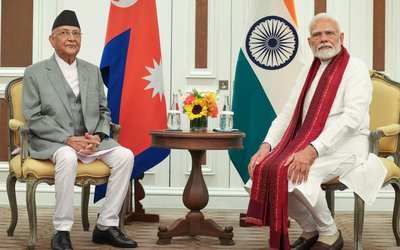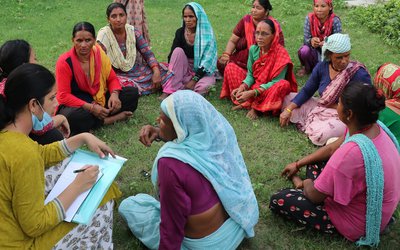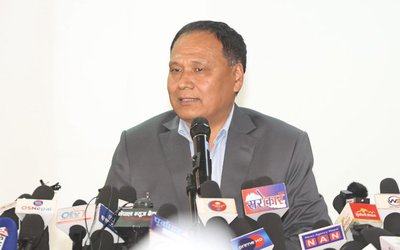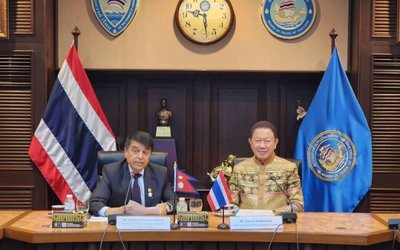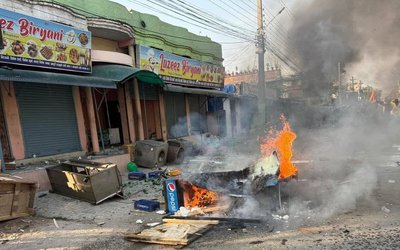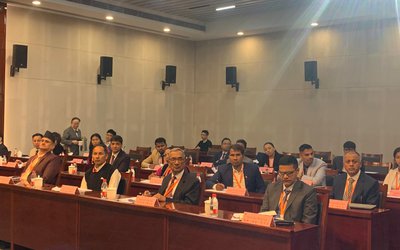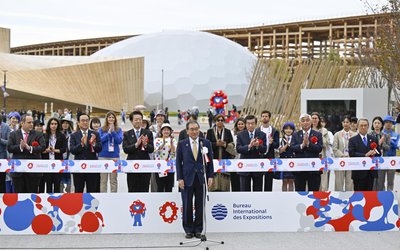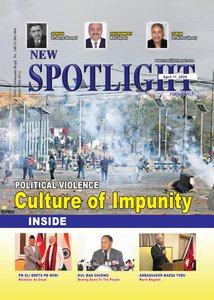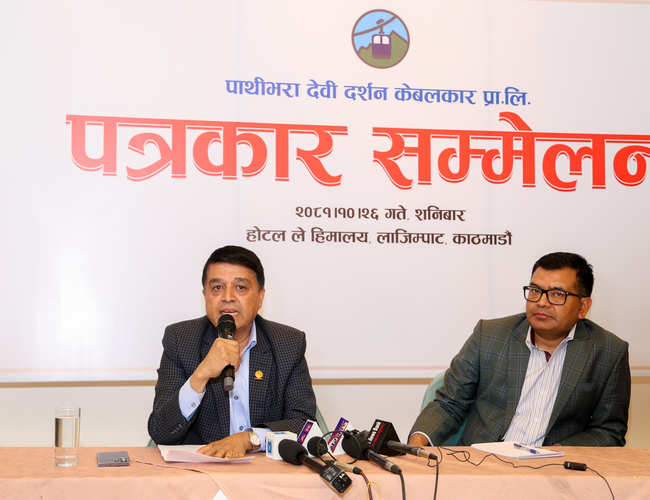
The construction of the Pathibhara cable car, which aims to connect the renowned Pathibhara Temple in Taplejung, a remote Himalayan district in Kosi Province, has sparked discussions. There have been rumors circulating on social media suggesting that the cable car project might impact the temple's historical significance and identity. The project received approval for construction in 2075, as per the decision of the Council of Ministers of the Government of Nepal.
Approximately two years ago, the involvement of the IME Group in the Pathibhara cable car project led to an acceleration in construction efforts. Following the acquisition of all necessary government and legal clearances from the Government of Nepal, the project was included in the national priority plan and progressed accordingly.
IME Group acquired a significant stake in the cable car project in 2079 with the goal of establishing tourist attractions with cable cars in all seven provinces of Nepal. The process of securing land rights for the cable car, transferring the land to the Government of Nepal in exchange for permission, has been successfully completed. Tree clearance along the cable car route, approval of the Detailed Project Report (DPR), and the commencement of physical construction work have all been finalized. The construction work officially began this month after the ceremonial laying of the foundation stone. The cable car, spanning 2.75 km from Fungling Municipality 11, Kaflepati to approximately 700 meters west of the Pathibhara Devi temple complex in Taplejung District, will feature 36 passenger gondolas and two cargo gondolas.How will the local economy be affected by the cable car project?
The construction of the cable car will reduce the travel time from the lower station to the upper station to just 10 minutes and 31 seconds. The equipment and components for the cable car will be provided by a renowned global cable car company. Basic amenities such as water, toilets, and oxygen will be available at the upper station for the convenience of pilgrims, with no additional structures planned to preserve the temple premises and its surroundings.
The cable car will offer a convenient transportation option for children, the elderly, and individuals with physical disabilities, as well as for pilgrims and tourists. Those who prefer to hike will not be hindered by the cable car's presence on the current route.
Furthermore, it is anticipated that there will be a notable increase in both domestic and international pilgrims and tourists as a result of the cable car project.
The Pathibhara cable car project is estimated to cost 3 billion rupees and is expected to create direct employment opportunities for around 300 people. Local residents will be given priority, with about 80 percent of the workforce coming from the local community. Similar to other tourism projects by the IME group, locals will have the chance to invest in and benefit from the cable car project.
The construction of the cable car is anticipated to boost pilgrimage and tourism, leading to increased economic activities in the region. This growth will support local production sectors such as agriculture, household goods, and handicrafts. The project is also expected to stimulate self-employment and business expansion in various sectors, including hotels, restaurants, and transportation along the Barah area of Mechi Highway to Jhapa and Sunsari of Tamor Corridor. This economic development will result in higher tax revenues for the state.
Cable car is the safest and most environmentally friendly means of transportation in the world. Since this means of electric transport does not cause any kind of pollution, it is kept within the standards of sustainable development.
Furthermore, to minimize the environmental impact, the plants planted in the alignment area of the cable car will be maintained and protected for 5 years, with 25 trees planted for every tree cut. Subsequently, these plants will be handed over to the Government of Nepal. The implementation of the cable car project will contribute to the preservation of biodiversity and the environment. Despite the commencement of the Pathibhara cable car project, some individuals have initiated actions to impede the construction process and deter private investment. These actions include baseless accusations that tarnish the reputation and integrity of the private sector. Criticizing the entire private sector regarding the cable car project and disregarding their societal, economic, and national contributions is regrettable. The challenging terrain, high altitude, and steep ascent make it arduous for pilgrims and tourists to access the temple, especially for individuals with mobility issues, illnesses, disabilities, children, and the elderly. Some individuals charge exorbitant fees, ranging from 10,000 to 15-20 thousand rupees per person, to transport pilgrims to the temple, causing dissatisfaction among visitors.
There is an option to access the Pathibhara temple via helicopter charter as well. The cable car serves as a vital mode of transportation, offering a unique opportunity for the public to witness Pathibhara Devi, attracting a significantly higher number of pilgrims and tourists, generating employment opportunities for locals, enhancing living standards, and promoting environmental conservation and biodiversity preservation.
Furthermore, the project has committed to allocating a percentage of the cable car's profits towards initiatives such as healthcare, education, and local infrastructure through corporate social responsibility programs managed by local authorities.
IME Group's recent involvement in the Pathibhara Cable Car Company, established in 2075, highlights the long-standing discussion surrounding the construction of a cable car in this sacred location. Therefore, the current debate on nationalizing the cable car project should be approached with caution.
After the involvement of IME Group, the cable car construction project has gained momentum. We have engaged in discussions with local representatives, political leaders, the local administration, various industrial associations, and other stakeholders in the district, urging them to support the cable car construction.
Some locals initially opposed the construction of the cable car, but we took their feedback into consideration and made adjustments to our Detailed Project Report (DPR) to address their concerns.
However, there is now an unnatural interest from individuals outside the district or country who are against the cable car project, which is misguided. We are closely connected to the project site and understand the sentiments and needs of the residents of Taplejung district.
It is unfortunate to see unnecessary debates about the cable car project being fueled by those who are not directly impacted by it. Such discussions detract from the development efforts in the region.
Such actions are discouraging private investment in the country for the future. It is disheartening that work is being halted even after completing all legal and regulatory procedures by state agencies. This has rendered the private sector's efforts to attract investment to the country ineffective.
Our goal of attracting more domestic and foreign tourists by developing large-scale tourist infrastructure in all seven provinces, creating numerous investment opportunities, generating employment, and contributing to building a prosperous Nepal has been hindered.
It is unfortunate that local residents have to seek employment abroad while efforts are being made to challenge the job opportunities coming to their communities. In this situation, I trust the people of the district to discern between what is beneficial and detrimental.
Dhakal stated, "As the chairman of IME Group, the cable car company, and the Federation of Nepal Industry and Commerce, the country's private sector umbrella organization, I am actively seeking investment in Nepal during my visits to various countries."
In the event of any delays in this project, its impact will be felt on a global scale. I urge all stakeholders once again to support the development work without causing any hindrances. It is important to remember that the cable car is simply a mode of transportation. The construction of the cable car at this heritage site will not disrupt any religious, cultural, or traditional practices, but rather enhance and preserve the existing structures. (Statement made by
Chandra Prasad Dhakal, chairperson of by Pathibhara Devi Darshan Cable Car Pvt. Ltd. Excerpts of his statement delivered during the press meet.
- Nepal Has A Significant Opportunity To Grow Through Foreign Direct Investment (FDI)
- Apr 11, 2025
- Obstruction To The Pathibhara Cable Car Project Could Harm Investment And Business In Nepal
- Mar 07, 2025
- IME Group Is Dedicated To Investing In The Prosperity And Development Of Nepal
- Dec 29, 2024
- Nepal's Hospitality Industry Is Ready To Welcome Chinese Tourists
- Sep 25, 2023



